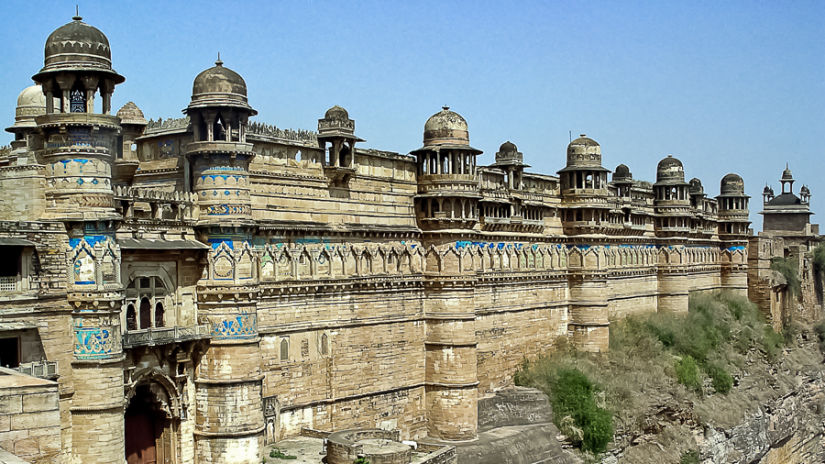Neemrana’s heritage hotel near Gwalior fort is also a non-hotel hotel because it was originally built as a garden. Great efforts have been made to maintain the old charm of Deo Bagh while ensuring more than the basic comforts that have come to be associated with the changes in lifestyle since the 17th century. Deo Bagh offers a unique opportunity to wake up in a Char Bagh where Mughal emperors once camped! There are various things to do in Gwalior, including local excursions and sight-seeing in and around Gwalior that help our guests rediscover real India off the beaten tourist track. Besides these things to do in Gwalior, is the experience of visiting a char bagh and the temple-cenotaphs at Deo Bagh itself! Our heritage hotel in Gwalior enables one to graduate– from tourist to traveller! Deo Bagh also hosts birthdays, anniversaries, and other memorable occasions.
Gwalior Fort
The Gwalior fort is in close proximity to Deo Bagh and its antecedents date back to the 8th century. It is positioned on an isolated rock mass and contains a number of historic buildings. This fortress has been integral to the history of the North Indian kingdoms and has been described as “The pearl in the necklace of the forts of Hind” in the words of the Mughal Emperor Babur. It is one of the biggest forts in India and a great attraction for visitors. A must visit !

Urvai Gate Rock Sculptures

The most impressive sculptures are those along the long climb up from Urvai Gate. These rock sculptures date back to the 15th century, and represent nude figures of tirthankars (the 24 great Jain teachers) that were defaced by Babur’s army in 1527. They are carved into the cliff face and are numbered in white lettering at the base.
Teli ka Mandir

Tansen ka Makbara

In the same compound of the Gwalior Fort is the smaller, simpler Tomb of Tansen, a singer much admired by Akbar and held to be a father of Indian classical music. Chewing the leaves of the tamarind tree at Tansen's grave supposedly enriches your voice and during the Tansen festival in October/November it takes on an unseasonably autumnal look when stripped by visiting singers.
State Archaeological Museum
This museum is within Gujari Mahal, just past Gwalior Gate, at the base of the fort. Built in the 15th century by Man Singh for his favourite Rani, the palace has, now deteriorated. There’s a large collection of Hindu and Jain sculptures, including the famed Salabhanjika (an exceptionally carved female figure) plus copies of the frescoes in the Bagh Caves.

Sas Bahu Temple

A 9th century shrine, the Saas-Bahu temple in the fort allures not only the devotees but also the visitors with its artistic value. Although the name indicates a connection, these temples are not dedicated to Sas (mother-in-law) and Bahu (daughter-in-law) but rather a popular derivation of Sahastra-bahu, another name of the ‘thousand-armed’ Lord Vishnu.
These temples are situated adjacent to each other and are similar in style. The larger one is elaborately decorated with beautiful carvings and sculptures of the deity. The roof of the larger temple is adorned with a marvellous lotus carving which is very fascinating. These ancient temples display exceptional architectural brilliance and are definitely worth a visit.
Jai Vilas Palace
The Jai Vilas Palace, down in central Gwalior, was built by Maharaja Jayajirao in 1874 using prisoners that were captured in the Gwalior Fort. The convicts were rewarded with the 12-year job of weaving the hall carpet, the largest in Asia. This European style palace has been converted into a museum and is known for its unique architecture which is a mix of Italian, Tuscan and Corinithian.
The Museum exhibits a collection of antiques belonging to the Scindia reign which were originally from Italy, France, and Versailles. Two Belgian chandeliers weighing several tonnes are said to be the largest pair in the world. Further, swords that were once used by Aurangzeb and Shah Jahan are rather conspicuous and catch one’s eye.

Maharaja memorabilia fills the rooms: Belgian cut-glass furniture and stuffed tigers. There's a ladies-only swimming pool with diving boards, a boat and a wine cabinet. The cavernous dining room displays the pièce de résistance, a model railway with a silver train that carried after-dinner brandy and cigars around the table in crystal coaches.
Deo Bagh - 17th century, Gwalior, creates memorable holidays and is a perfect weekend destination from New Delhi. Our heritage hotel in Gwalior hosts 15 the palatial rooms along with resplendent Neemrana ambience.